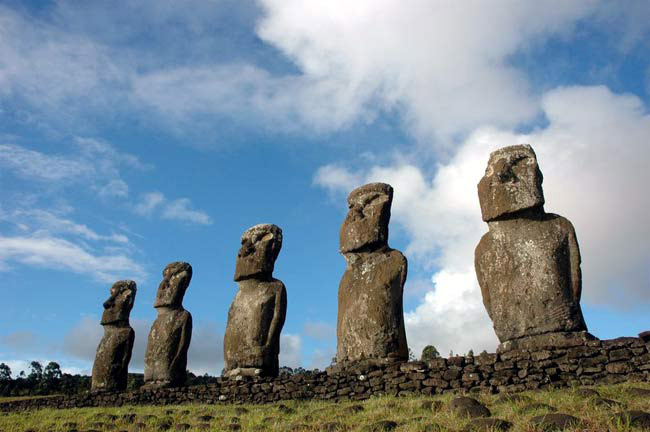Easter Island Is Place to Be for Sunday Solar Eclipse

On Sunday, the moon will pass betweenthe sun and the Earthand throw its dark shadow upon our planet's surface in one of nature'sgreatspectacles: a total eclipse of the sun. It could be the ultimate cosmicphotoop, but only if you're on the remote Easter Island.
The July11 solar eclipse will mark the third summer in a row such acelestial eventhas occurred. But unlike last year, when literally tens of millions ofpeopleexperienced the passage of the shadow as it swept across India andChina,Sunday's eclipse will be experienced by at best, tens ofthousands.
Still, there will be several thousandindividuals who arehoping to get a view of the totally eclipsed sun from perhaps one ofthe mostisolated and remote spots on the face of the Earth: the legendary andmystical EasterIsland.
A recordnumber of visitors are there now towitness Sunday's big sky show, many of whom hoping to get what likelywill bethe photo-op of the century: capturing an image of the solarcorona with oneor more of Easter Island's enormous statues, known as "moai," in theforeground!
Writesscience journalist, DanFalk: "I've been looking forward to this remarkable natural event formorethan a decade. It's an incredible, once-in-a-lifetime opportunity. Iintend topull this off without any kind of digital manipulation.
"Obviously,with Photoshop,one could pretend to have witnessed a total eclipse over the EiffelTower, orfrom inside your local Starbucks for that matter. But where's thechallenge inthat? My goal is to capture a single, unique scene, just as it appearedto theunaided eye."
(Thisgraphic shows the ground track depicting where this totaleclipse of 2010will be visible from and when.)
Breaking space news, the latest updates on rocket launches, skywatching events and more!
The largest concentration of eclipsewatchers will likelycongregate within the Patagonian town of El Calafate, which is at thevery endof the eclipse path. But, as I recently mentioned in an interview onNPR'sScience Friday, you could probably put the total number of people whoarewithin the totality path of Sunday's eclipse inside Yankee Stadium,with plentyof room to spare.
Thelast time a total solareclipse was visible from Easter Island was more than 13 centuries ago,on Sep.24, 656 AD, and the next time islanders get to see one will be 314years fromnow, on Feb. 25, 2324.
Hereis an extra fact to dwellupon as eclipse day nears: since anthropologists believe the island wasonlysettled no earlier than 700 A.D. means that until this coming Sunday,no humaninhabitant has ever seen a total solar eclipse from the island.
Exotic eclipse locale
Easter Island, also known as RapaNuior Isla de Pascua, is aspecial territory of Chile. It is a breathtaking open-air museum andUNESCOWorld Heritage Site with much of the island protected within the RapaNuiNational Park.
Fortuitously, it is also positionedalmost directly withinthe path of the moon's shadow on Sunday affording both natives andtourists theopportunity to witness a total solar eclipse. [SolarEclipse Photos]
The name"Easter Island" was givenby the island's first recorded European visitor, the Dutch explorerJacobRoggeveen, who encountered it on Easter Sunday, April5, 1722, while searching forDavis or David's island. Theisland's official Spanish name, Isla de Pascua, isSpanish for "EasterIsland."
It is2,236 miles (3,600 km) west ofcontinental Chile and 1,289 miles (2,075 km) east of thePitcairn Islands (Salay G?mez 257 miles (415 km) to the east, is closer but uninhabited). Itisdirectly due south of Salt Lake City and directly due east of Brisbane,Australia. Easter Island is also the easternmost and almost thesouthernmostisland of the South Pacific.
Approximately 1,200 or 1,300 yearsago a double-hulled canoefilled with seafarers from a distant culture landed at Easter Island.Over thecenturies that followed a remarkable society developed in isolation ontheisland.
For reasons still unknown they begancarving giant statuesout of volcanic rock. These enormous "moai" monuments are some of themost incredible ancient relics ever discovered.
Atleast 288 of these once stoodupon massive stone platforms called ahu. There are some 250 of theseahu platformsspaced approximately one half mile apart and create an almost unbrokenlinearound the perimeter of the island.
Another600 moai statues, invarious stages of completion, are scattered around the island, eitherinquarries or along ancient roads between the quarries and the coastalareaswhere the statues were most often erected. The average statue is 14feet, 6inches tall and weighs 14 tons.
Dependingupon the size of thestatues, it has been estimated that between 50 and 150 people wereneeded todrag them across the countryside on sleds and rollers made from theisland'strees.
A mere4,000 people live on this 64 squaremiles (166 square km) patch of hills and volcanoes. And yet, despitebeing themost remote inhabited island on Earth, tourism has boomed, going from22,000tourists in 2003 to more than 50,000 in 2006. With the opening ofMataveriAirport in 1967, travel to Easter Island from Chile and Tahiti becameeasy. ABoeing 767 flies from Papeete (Tahiti) and Santiago to Easter Islandtwice aweek.
What Easter Island eclipsehunters may see
From Easter Island, at 18:41 UT(12:41 p.m. local time), themoon will begin to interpose the edge of its disk between the sun andtheEarth; within a few minutes a small scallop of darkness will appear onthe sun'sleft edge. Slowly, the moon will glide across the face of the sun,graduallycutting it down to a crescent. Finally, the sun will be amere curved threadof light bordering the upper right edge of the black mass of the moon.
At 20:08:30 UT (2:08:30 p.m. localtime) the vast "wallof darkness" which belongs to the moon's approaching umbral shadow willrush in; the northwest sky will appear to darken dramatically as ifsome greatstorm was brewing.
As the crescent fades into to a thinfilament of light, itwill not go out like a snuffed candle, but might disintegrate eitherintoirregular dots and points of light known as "Baily's Beads," orperhaps just a singular bead of silvery light set on a thin luminousring ? theinner corona ? producing a beautiful"Diamond Ring" effect.
The rather clammy light of the waningsun will seem to rushout in a deathly silence, as if suddenly immersed in avacuum.
The darkened sun will stand nearlyhalfway up in the skyabove the north-northwest horizon during Easter Island's 4 min. 41 sec.of totaleclipse. As the waning solar crescent is fading away, some of thebrighteststars and planets will appear.
Several minutes before totality,brilliant Venus, the thirdbrightest object in the sky next to the sun and moon will begin tobecome evidenthigh in the northeast. The most spectacular view, however, is affordedby thecorona, a marvelous fringe of pearly white light. It differs in size,in tintsand patterns from eclipse to eclipse.
It is always faint and delicate, witha sheen like a paleaurora. It has a variable appearance. Sometimes it has a softcontinuous look;at other times, long rays of it shoot out in three or four directions.It maystand out from the disk in stiff streamers or end in brushlike tips.
Uncertain weather
The biggest concern for viewers willof course be the localweather.
Located in the heart of the PacificOcean, south of thetropic of Capricorn, Easter Island features a sub-tropical climateinfluencedby winds and ocean currents causing considerable variations throughouttheyear. The island is exposed for most of the year to the trade windsblowingtoward the northeast. The "high" season for visiting EasterIslandis from December through March, when sky conditions are sunniest andthe leastamount of precipitation falls.
This is especially true in Decemberand January, wheremonthly rainfall averages about 3 inches (75 mm), although showers areonlysporadic and last a shorttime.
Unfortunately,the eclipse will occur duringthe wet winter season and occasionally,heavy rainfall andrainstorms strike the island. These occur mostly in the winter months(June-August) and the eclipse falls right in the middle of this timeframe!
Average daytime cloudiness approaches60 percent. Thepercent of possible sunshine is a little less than 50percent. About nearly4.2 inches (108 mm) of rain falls in July with a 1 in 6 chance of rainfallingat eclipse time.
day's eclipse is the second solareclipse of 2010, butthe first and only one expected to be a total solar eclipse. A partial,orannular solar eclipse, occurred on Jan. 15.
- Gallery? Solar Eclipse Photos
- BeginnerAstrophotography Telescopes
- WhatCauses Solar Eclipses?
Joe Rao serves as aninstructor and guest lecturer at NewYork's Hayden Planetarium. He writes about astronomy for The New YorkTimes andother publications, and he is also an on-camera meteorologist for News12 Westchester, New York.

Joe Rao is Space.com's skywatching columnist, as well as a veteran meteorologist and eclipse chaser who also serves as an instructor and guest lecturer at New York's Hayden Planetarium. He writes about astronomy for Natural History magazine, Sky & Telescope and other publications. Joe is an 8-time Emmy-nominated meteorologist who served the Putnam Valley region of New York for over 21 years. You can find him on Twitter and YouTube tracking lunar and solar eclipses, meteor showers and more. To find out Joe's latest project, visit him on Twitter.
